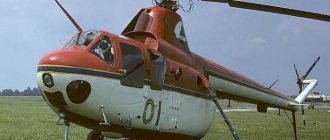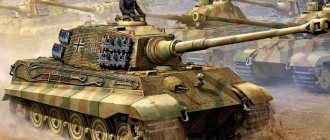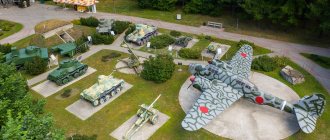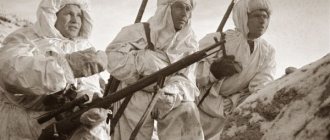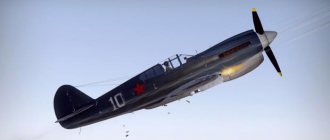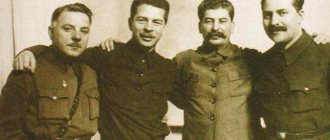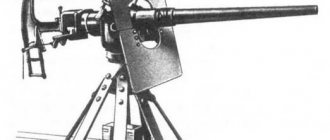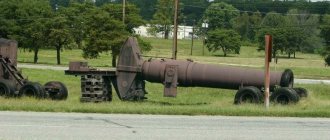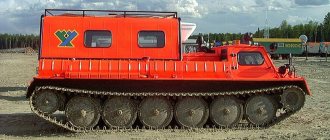The history of the appearance of an armored vehicle, which formed the basis of the modern domestic school of tank building
The T-44 medium tank, although it was developed in 1943-44, did not make it to the war, and therefore did not become as widely known as its predecessor, the legendary T-34. But in the history of domestic tank building it occupies a very special place. “Forty-four” became the very machine on which Soviet designers mastered many technical solutions and techniques that were completely new to them. It was they who subsequently formed the basis for most Soviet post-war tanks. And the T-44 itself, or rather, its deep modernization, became famous under the symbol T-54 and even more so as the T-55, one of the most popular USSR tanks produced after the war.
Don't redo it, but do it again
The appearance of German Panthers on the Kursk Bulge showed that without serious modernization, existing Soviet medium and heavy tanks cannot fight them on an equal footing. The armor was inferior, the range and penetration of the gun was inferior... In a word, a new tank was required. By that time, it had already become clear that an attempt to simply modernize the T-34, known as the T-43, did not give the required result. And then two other tanks were born: T-34-85 and T-44. The first was a modernized “thirty-four” with reinforced weapons and a crew increased to five people, the production of which could be quickly mastered on the same assembly lines where these tanks were already being produced. The second was a real revolution in domestic tank building.
The design team under the leadership of Alexander Morozov at plant No. 183 in Nizhny Tagil understood that it was possible to create a tank that would not only be better than the T-34, but would also have a sufficient modernization reserve, under one condition: it would be completely different. And just as in Germany they carefully studied the design of the “thirty-four” to make the “Panther,” so the Morozov Design Bureau took into account the experience of German tank builders. First of all, this concerned the turret located almost in the center of the hull. This placement solved quite a few problems that the T-34 suffered from, primarily with the placement of the driver’s hatch not in the frontal armor plate, but at the top. Front-line experience showed that it was this hatch that became the weakest point of the “thirty-four” when fired from the front, and this problem certainly had to be solved.
To place the turret in the center of the hull, it was necessary to solve another problem - to change the length of the engine and transmission compartment. This was impossible to do on the T-34, since the engine was located along the longitudinal axis of the tank. Consequently, it was necessary to install the engine transversely, which had not been done in the USSR since the days of the first Soviet production tank T-18. Nevertheless, his experience proved that this task was feasible. True, on one condition: it is necessary to expand the engine compartment. Alexander Morozov's design bureau solved this problem in an original way: they changed the suspension system. The previous one, spring-loaded, required special fenders, which reduced the internal space. The new torsion bar freed the tank from this drawback, allowing the sides to be made vertical. This means that it was possible, without changing the width of the hull too much, to place the engine across, move the turret back - and get a completely new, essentially, tank. Moreover, compared to the T-34-85, it had one more advantage: the crew of four did not have a gunner-radio operator, therefore, the manpower needs of tank units were reduced.
Stories about weapons. T-44 tank outside and inside
What did the events of the Great Patriotic War show regarding the T-34 tank?
At the initial stage, it was a wonderful machine, far ahead of its contemporaries. At the final test, using the T-34-85 as an example, it became clear that there was no room to modernize the vehicle. World tank building was moving forward at ten-kilometer paces, and the T-34 clearly could no longer keep up with its “classmates.” Yes, some changes to the turret and the installation of a more powerful 85-mm cannon did the trick, but then it turned out to be a dead end.
And at the end of 1943, Soviet designers came to the conclusion that something had to be done.
Initially, the layout of the T-34 was designed so that the V-2-34 engine occupied almost half of the entire internal space of the tank.
The turret had to be moved forward as much as possible, and the crew had to be shoved around the remaining space. As a result, as we have already noted, it was very cramped inside the T-34, but this is not the worst thing. The unpleasant thing was that it became impossible to further increase the frontal armor and install a more powerful gun. This was caused by a serious overload of the chassis in the front of the tank.
Therefore, already in 1943, a worthy replacement for the T-34 was prepared, developed by the design bureau (department No. 520, chief designer A. A. Morozov) of the Ural Tank Plant No. 183 named after Stalin, which received the working index T-44, or object 136.
The main task for the designers was a complete redesign of the tank's engine and transmission compartment. Managed. The T-44 engine was installed not along, but across the hull and connected to the gearbox with an overdrive gearbox. It was also possible to reduce the engine height by moving the air cleaner to the side, moving the radiator across the body behind the gearbox and moving the fan to the rear of the tank.
The layout was not just more successful: in comparison with the T-34, the cooling of the transmission units was significantly improved on the T-44.
The fighting compartment has not just increased. If you transfer from T-34 to T-44, you feel like you are in a modern apartment after Stalin, the internal free volume increases so much. The turret could be moved to the center of the hull, closer to the center of gravity of the tank. This increased balancing and had a positive effect on the accuracy of fire on the move. The modernization potential has increased, there was now enough space even to install a 122-mm cannon from the IS-2.
The load on the front rollers has been reduced, which means it has become possible to increase the frontal armor of the hull to 90 mm, and the frontal armor of the turret to 120 mm.
The angle of inclination of the frontal sheet was increased to 60°, and it became monolithic. If in the T-34 the weak point was the driver's hatch, located in the frontal armor plate, then on the T-44 the driver's hatch was completely removed from the hull.
The tank crew was reduced to a gunner-radio operator, since the tank commander handled the maintenance of the radio station. In addition, the tank commander receiving orders directly from his superiors, rather than through a crew member, increased efficiency.
The frontal machine gun was left, but now it was rigidly fixed in the frontal armor, and the driver fired from it. A fuel tank was placed in the vacant space of the radio operator.
Well, the crew became much more comfortable.
TTX T-44:
Combat weight, t 31.0 Crew, people. 4
Years of production 1944—1947 Years of operation 1945—late 1970s Number of produced, pcs. 1823
Dimensions Hull length, mm 6070 Length with gun forward, mm 7650 Hull width, mm 3180 Height, mm 2410 Base, mm 3800 Track, mm 2630 Ground clearance, mm 425
Reservation Front of hull (top), mm/deg. 90 / 60°[1] Housing forehead (bottom), mm/deg. 90 / 45°[1] Hull side, mm/deg. 75 / 0°[1] Bottom, mm 15[1] Hull roof, mm 15—20[1] Tower forehead, mm/deg. 120 Tower side, mm/deg. 90 / 20°[1]
Armament Caliber and brand of gun 85-mm ZIS-S-53 model 1944 Gun ammunition 58 Angles VN, deg. −5…+25° Machine guns 2 × 7.62 mm DTM
Mobility Engine power, l. With. 500 Speed on the highway, km/h 60 Speed on rough terrain, km/h 25..30 Cruising range on the highway, km 200..250 Cruising range on rough terrain, km 180..200 Climbability, degrees. 30 Wall to be overcome, m 0.73 Ditch to be overcome, m 2.5 Ford to be overcome, m 1.3
Having significant external similarities with the T-34-85, the T-44 was radically different from it in dimensions, layout and design.
Replacing the old, heavy and bulky Christie spring suspension with a torsion bar suspension freed up quite a lot of space. This is what made it possible to completely reconsider the layout of the tank.
The fender niches disappeared, and the freed up space made it possible to position the new B-44 engine not along, but across the tank’s hull. By turning the engine, the fighting compartment was increased and the working conditions of the crew were improved.
After making a number of minor design modifications, the T-44A was put into service on November 23, 1944.
The first five production vehicles left the KhTZ workshops in November 1944. In total, during the production period from 1944 to 1947, 1823 T-44 tanks were produced.
However, they did not go to the front and did not participate in the hostilities of World War II.
Moreover, almost immediately after the launch of production at the end of 1944, it became clear that in terms of armament the T-44 could not be considered as the main combat vehicle. The 85-mm cannon had practically exhausted its capabilities and was not suitable for fighting modern tanks.
It was decided to begin work on the next modification of the tank - the T-44B, equipped with a 100 mm D-10 cannon. Work began in October 1944, design was completed in December 1944, and the prototype was manufactured by February 1945.
The tank successfully passed tests and was recommended for adoption. It differed from the “basic” T-44 model in many ways: a new gun, a turret of a different configuration, an engine, a different armor scheme.
In fact, it was a completely different tank, so instead of the letter “B” the vehicle received its own name, under which it was soon put into production - T-54.
But that's a completely different story.
In 1961, all produced T-44 tanks were modernized in order to unify the chassis with the main Soviet T-54 tank. In addition, the vehicles, designated T-44M, received night observation devices and increased ammunition, and a second radio station was installed on the command T-44MK due to a decrease in ammunition.
In 1965, part of the T-44 was converted into BTS-4 armored tractors, and in 1966, the remaining tanks were equipped with a two-plane weapon stabilizer, which increases the accuracy of firing on the move. These vehicles were designated T-44S. At the end of the 1970s, the T-44 was removed from service with the Soviet Army.
The only armed conflict in which the T-44 participated was Operation Whirlwind. In addition, at the end of their service, the vehicles still had the opportunity to “participate” in the Great Patriotic War: in the role of the German Pz VI “Tiger” tanks in the films “Liberation” and “They Fought for the Motherland.”
Still from the movie “Hot Snow”
Still from the film series “Liberation”
After appropriate modifications, the tanks became indistinguishable from German vehicles (with the exception of the chassis).
In 2004, this tank was depicted as the Pz VI "Tiger" in the film "Bunker". This tank can also be seen in the films “Father of a Soldier”, “Officers”, “On the Way to Berlin”, “On the Roads of War”, “Native Blood”, where it “plays” the role of the T-34-85.
The tank is shorter, the gun is thicker
The transverse arrangement of the engine made it possible to solve two more problems that worried the warring tank crews. Firstly, reducing the length of the tank provided a significant gain in weight, which could be used to increase the thickness of the armor. Secondly, moving the turret back unloaded the front part of the suspension, which again made it possible to make the frontal armor plates thicker.
The country's leadership immediately appreciated these advantages of the new layout. Chairman of the State Defense Committee Joseph Stalin, who learned about the project for a new tank already in December 1943, took its development and production, figuratively speaking, under personal control. By this time, the first developments on the T-44 topic had passed the necessary approvals from the military and the People's Commissariat of the Tank Industry, and at plant No. 183 (the current Uralvagonzavod) work was already in full swing on the production of prototypes of the new vehicle.
They built not one tank, but three at once, noticeably different from each other. This was especially noticeable in the vehicle, which received a 122-mm cannon as an experiment, whose shells could easily cope even with the frontal armor of Panthers and Tigers (heavy IS-2 tanks were armed with the same gun). The other two tanks were armed with the same 85 mm cannons as the T-34-85, and they differed only in their turrets. In one vehicle it was closer in characteristics to the turret of the new T-34, in the other it was closer to one of the T-43 variants.
The last of the tanks was the first to be tested at the end of January 1944, which showed that the vehicle was lighter, faster and more economical than the serial T-34-76 that accompanied it on test runs. The second model with an 85 mm cannon also successfully passed tests, but the tank armed with a 122 mm gun was considered unpromising due to its low rate of fire. After testing at the NIBT test site in Kubinka near Moscow, the new tank was recognized as promising, but, as usual, many defects, shortcomings and inconveniences for the crew that accompany any experimental vehicle were noted. They were all fixable, but it took time. Surprisingly, the creators of the T-44 had plenty of it: despite the obvious superiority over the T-34, the “forty-fourth” was not rushed into production. This was explained simply: the front needed as many tanks as possible in the shortest possible time, and this requirement could be fulfilled only by retaining the T-34 and T-34-85 as the main production vehicle, which had already been adopted in January 1944. weapons.
Throughout the first half of 1944, the design bureau of plant No. 183 was engaged in fine-tuning and reworking experimental T-44s. The military and testers had a lot of comments, and even more problems were revealed by the experimental shelling of the hulls of the new tank at the test site. In particular, it became clear that the driver's cabin proposed by the design bureau, which replaced the hatch in the front armor plate, still remains the weak point of the vehicle. The military demanded an increase in the thickness of the armor, especially the frontal and side armor. The rear armor plate, which stood vertically, could not withstand shelling from even the smallest caliber shells. In addition, it was necessary to redo the turret, in which a new S-53 gun was now installed - the same as they began to install on the T-34-85. In a word, there was a normal work process to fine-tune the tank, which they clearly intend to put into service.
Late to the war
This decision was made in the middle of the summer of 1944. On July 18, a decree signed by Stalin was issued on the start of mass production of the new T-44 tank at factories No. 75 in Kharkov (the legendary Kharkov locomotive, where the "thirty-four" was once created) and No. 264 in Stalingrad. The first combat vehicles were planned to be received in November of the same year. But before serial production began, Alexander Morozov’s design bureau managed to build another experimental version of the “forty-four,” which featured better armor protection and lost the driver’s cabin. It was this option that was eventually put into production.
The main, and soon the only enterprise for the production of T-44, became the restored Kharkov plant No. 75. It was here that at the end of November 1944 the first five “forty-fourths” were assembled, which at the beginning of December went straight to tank schools and tank training brigades. Many subsequent vehicles also went there, since both at the plant, and in the People's Commissariat of the Tank Industry, and in the Red Army, they well understood that sending a vehicle suffering from a host of “childhood diseases” to combat units was risky.
As a result, the T-44 never had time to take part in the Great Patriotic War. The first vehicles that were recognized as suitable for combat units entered the 5th Guards Tank Army only in the late spring of 1945, and they did not have the chance to reach the front. But they had a surprisingly long service history. In 1956, T-44s took part in hostilities for the first and last time during anti-Soviet protests in Hungary. At the end of the 1950s, all the “forty-fours” available in the army were modernized to the T-44M level. This modernization represented the unification of the engine, transmission and chassis with the T-54 tank, which by that time had become the main one in the Soviet army. It is noteworthy that the “fifty-four” itself was a deep modernization of the T-44 - now the progenitor was brought up to the level of its descendant. After this, the “forty-fours” served until the end of the 1970s, until they were gradually withdrawn from service.
In just three years of production (1944-1947), Kharkov plant No. 75 produced 1,823 T-44 tanks. The vast majority of them were used as training ones, not only in the Soviet army, but also in the armies of the Warsaw Pact allies. This turned out to be convenient, since in many ways the more common T-54 was its successor. In a sense, this tank turned out to be a “training tank” for the domestic tank building industry, although it would be more accurate to call it a milestone: it was on it that the approach to tank design radically changed and the post-war school of designing tracked combat vehicles began to take shape.
Soviet [not really] steel monster KV-44
The backstory is ordinary, like everyone else who has children. At some point you cave in, show YouTube, and off you go. So you imperceptibly move from the same “Blue Tractor” to “Paw Patrol”, then to “Super Wings” and, in principle, with the intermediate ones you could get to “Treasure Island”, but then fortune, who escaped from the same cartoon, intervenes, and we Already everyone has become deeply hooked on Gerand's channel and his steel monsters.
Well, since the main, well, one of the main, heroes is the super-heavy tank KV-44, it’s clear who I wanted to print.
To begin with, I studied the materiel, namely, the available images of the KV-44 from cartoons and, at the same time, the unique original:
By all appearances, both were Frankensteins in a sense. The original is larger, the cartoon is smaller. But in any case, it turned out that even if you decided on the number and location of the towers, simultaneous shooting turned out to be impossible - this is not a gan-kata for us. Here it is clear to the little one that you will shoot yourself before you hit the enemy.
Therefore, as much as I could, I abstracted myself from rationality and began to make the KV-44. To understand what the KV-44 is:
So, what should the KV-44 be like? That's right: huge, dangerous and so that the eyes glow red. And the print area of my printer is only 220x220 mm according to the characteristics and, at best, 200x200 in practice.
So it all started with the fact that I broke the tank platform into three parts and began to think about how to then fasten them together so that nothing would fall apart or break. The first pairing option was nerve-wracking and I doubted its feasibility so much that I didn’t even try to type:
Here on the screenshot is half of the tank - this is how I drew most of it. After all, the tank was planned to be symmetrical, which means you can make half of it and then just mirror it.
From this same image you can understand that I was inspired, after all, by the KV-44 made by Gerand. In my defense, I want to say that, in my opinion, he is a classic KV-44 and it is not clear where our Ministry of Culture is looking.
After a number of iterations, I came up with a sandwich design for the base of the tank:
At the base of the half of the track block. The halves are because I don’t have a very good printer (and probably plastic) and the supports for PET-G printing break out with great difficulty, leaving behind a heartbreaking sight. So I tried to make the tracks and the tank in general so that the number of supports was minimal, taking into account my abilities, of course.
Another fundamental point is the unification and minimization of the range of printed parts. For this reason, the front and rear track blocks, as well as both connectors, are exactly the same. True, to be completely honest, the halves of the track blocks are slightly different, which is explained by the presence of ribs in order to at least hypothetically increase lateral rigidity and at the same time facilitate assembly.
I don’t know how clear the drawing is, but words would be even more confusing. For example, the meaning of the design is that the tracks are connected horizontally by a connector, and so that it does not go anywhere, covers are screwed on top in the form of the upper front, middle and rear parts. At the same time, the upper middle part extends to the front and rear, which, in my idea, should prevent the tank from breaking if you take it in a very barbaric way - only by the bow or stern.
By the way, from the same drawing it follows that the appearance of the tank can be changed by altering only part of the parts, for example, tracks or covers.
The next question is how to attach the towers, remembering that they all must rotate. Here the first version, as in the case of the tank platform, did not reach the final stage:
Her idea was to twist all the parts of the platform with a pin long enough to fit the towers on it. And a nut was planned on top. Here you can see that at the beginning I was still optimistic and hoped to print entire tracked blocks, and to have fewer supports, I planned to insert parts with rollers.
But I couldn’t figure out how to immobilize the stud nut with movable towers. I believe that the built-in Scrum manager came into play (I didn’t even know what it was, but I Googled it): if solving a problem takes too long, we throw everything into the abyss and start again.
And, surprise, here I got myself into the same nonsense again. I was haunted by the idea of a hairpin, so I came up with the idea of making it hollow and with ring grooves. Hollow - so that a screw fits into it to fasten the pin and layers of the tank platform, and with annular grooves - so that the turrets rotate along them, like on guides. In this case, the latching of the towers was ensured by the fact that the pin was split and was compressed while the tower was being installed. In general, there is no need to explain for a long time, taking into account the fact that this option also went to the dustbin of history. You see, it turned out to be very difficult to select the diameters of the holes and the height of the ring grooves to ensure the desired fixation and rotation force.
You can feel a piece of my pain in the following picture:
There are three dead-end solutions here at once. I already told you about the hairpin. Now about the towers. It was obvious that it was impossible to print towers with guns without supports. I also knew that I wouldn’t be able to do this with supports either—I would break it in the process of separating the supports. Plus, I thought that the cannons would be the first to break, which means that each such incident would entail resealing the entire tower. Therefore, turrets and cannons had to be printed separately.
However, in this case it was necessary to figure out how to fasten them together. For some reason I didn’t even try the version with threads - I immediately dismissed it and started making a latch. The idea was to print towers in vase mode (one perimeter, in a spiral) with a cutout for a cannon. The latch on the gun is two counter-directed truncated cones. With proper calculation, the cannon should have bent the front surface of the turret, spreading the edges of the cutout apart, and then snapped into place, allowing the cutout to close (forgive me if this seems overly erotic to some).
In short, the idea worked, but difficulties arose. For example, based on the concept of attaching turrets to ring grooves, the upper turret could not be printed in vase mode, and this automatically made the wall more rigid, to the point of making it impossible to properly install the cannon. In addition, it turned out not very aesthetically pleasing. After all, the tanks here should have swinging armor for the gun window, and not what I got.
Something had to be done about this. And, since I was primarily concerned about the pairing of the towers, that’s what I did. After experimenting with trying to get within tenths of a millimeter when combining parts, I realized a simple thing: the connection should be such that it does not require special precision when printing or special skills when assembling.
In general, it’s a pity that we had to abandon the towers in vase mode. It was not very easy for me to draw them personally, but from below they looked quite elegant:
Paradoxically, the final solution took the form of a dowel connection, which, if not for chance, I would not have taken into account at all. Randomness is “since nothing helps, let’s try it - we’ll lose five minutes, and we’ll close the question once and for all.”
Before the dowel, I spent quite a long time trying to breathe life into a latch with a through hole:
It didn't turn out very well. If the fixation was sufficient, then the connection turned out to be conditionally permanent. Literally: it broke when trying to take it apart.
There were many options, but they all had the same qualities in common:
Well, the field of experiments also turned out to be extensive:
And this dowel went into production:
Yes, at first the dowel was solid, but the connection with it rotated rather poorly and was difficult to disassemble, so sampling appeared.
To ensure the connection of the rotating lower tower with the fixed platform, I used a dowel insert:
It fits into a recess in the tank platform and is secured with the same screw that holds the platform parts together. The square shape prevents the insert from spinning and loosening the connection. At the same time, the wall is thick enough not to break when disconnected. And even if the insert breaks, it doesn’t matter, a new one is printed very quickly. By the way, none of my inserts have broken yet.
At the same stage, I applied the “let’s try and throw it away” principle to the threaded connection of the turrets and guns. Surprisingly, everything grew together - you just had to take into account the fact that the threads on the towers were slightly sagging, which was treated by slightly increasing the diameter of the threads on the cannon.
Another thing about the cannons is that I printed them in my favorite vase mode, which I had to abandon for the towers. There are two reasons: firstly, it’s beautiful (and fast). Secondly, when (and not if) such a gun breaks, it is quite easy to unscrew the remains by inserting a screwdriver of a suitable size inside.
Actually, there was a revolution here. The tank finally began to come together and was eventually assembled. The diagram looks something like this (without unnecessarily repeating details):
Or here's a small demo:
As the conditional drawings of the conditional towers were ready, I tried as best I could to check the kinematics - so that they rotated without touching the body parts. In general, everything worked out, but I did not take into account the location of the guns, so there was a small surprise regarding the unification of the towers. Despite the fact that the rear central turrets are exactly the same size as the front ones, one had to move the gun window, otherwise the gun would rest against the exhaust pipes when turning.
Front:
Behind:
The matter remained small. Exactly - with paint and stars. It so happened that I only had white plastic and in my haste I forgot to make recesses for the obligatory stars in the body and gun.
So I painted the stars and glued them to the body, and used acrylic spray paint for painting. And if everything is clear with the primer and black color, then I want to say that the REF 0310 (khaki) paint applied to the body simply shocked me. This turned out to be the very shade that I expected from military equipment.
Of course, I didn’t end up with 77 guns, but only 35 guns and 31 turrets on three platforms. At the same time, the unification resulted in the fact that there are only 6 types of guns, and 10 turrets. The size of the connecting nuts is one, the size of the screws is two. I tried to make the design such that if it breaks, the number of parts to restore would be minimal.
You can also see that the color quality is floating. Indeed, I made a mistake in the amount of paint and one khaki can was not enough for the tank. Therefore, in some places the brown soil is visible, and in others everything is covered with black paint, which, on the contrary, was left after painting the tracks. In general, although I was very pleased with the paint, ideally, of course, it is better to print the tank with already painted plastic.
In conclusion, I want to say that for all threaded connections I used the Nut job script, because I don’t know how to do it myself.
The model is already loaded into the 3DToday library. The approximate weight of the finished product is 760 grams.
Happy upcoming Victory Day!
